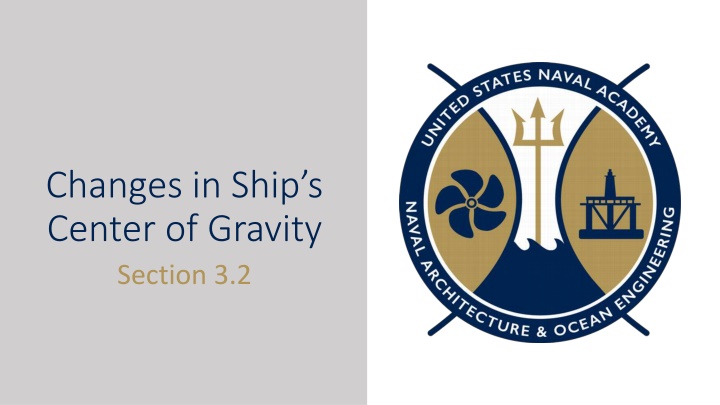
Changes in Ship's Center of Gravity and Weight Distribution
Explore the impact of weight distribution on a ship's center of gravity, including the effects of adding, removing, or shifting weight. Learn about key terminologies and the significance of maintaining equilibrium in ship design and operations.
Download Presentation

Please find below an Image/Link to download the presentation.
The content on the website is provided AS IS for your information and personal use only. It may not be sold, licensed, or shared on other websites without obtaining consent from the author. If you encounter any issues during the download, it is possible that the publisher has removed the file from their server.
You are allowed to download the files provided on this website for personal or commercial use, subject to the condition that they are used lawfully. All files are the property of their respective owners.
The content on the website is provided AS IS for your information and personal use only. It may not be sold, licensed, or shared on other websites without obtaining consent from the author.
E N D
Presentation Transcript
Changes in Ships Center of Gravity Section 3.2
Center of Mass/Gravity Center of Mass/Gravity (G or CG) The weighted average over area or volume based on given distribution summed such that result is equivalent to the total force applied through a single point Similar to Center of Buoyancy for defining LCG Longitudinal Center of Gravity, x axis TCG Transverse Center of Gravity, y axis KG Vertical Center of Gravity, distance from Keel to Center of Gravity, z axis What can change the Center of Gravity? Add weight Subtract weight Shift (move) weight/change distribution
Important Points F (LCF, TCF) Go (LCG, TCG, KG) Bo (LCB, TCB, KB) So far we ve looked at ships that are in STATIC EQUILIBRIUM: Fx = 0 Fy = 0 Fz = 0 p = 0 BL K CL Now let s take a look at what happens when a weight is added to disturb this equilibrium!
Terminology G = Location of Center of Gravity for whole ship g = Location of Center of Gravity for singular object s= Displacement of ship (LT) w = weight of object placed/removed/shifted G or CG = Center of Gravity LCG = longitudinal Center of Gravity, x axis TCG = transverse center of gravity (left / right), y axis KG (aka VCG) = keel to center of gravity / vertical center of gravity, z axis
Move Weight Change in G A change in weight (either adding, removing or shifting it) causes a change in the location of G, the center of gravity of the ship z-axis Change in VCG (or KG) KGnew y-axis Change in the TCG TCGnew x-axis longitudinal CG (LCG) in x-axis (focus on later in Chapter 3)
Changes in Center of Gravity 3 Types of Weight Movements 1. Weight Addition 2. Weight Removal 3. Weight Shift = Weight removal + Weight addition Fleet Applications: Food on/off loads Weapons movements Hovering/trim operations Flooding Operational tests Removal of hatches Flooding or pump down of tanks for maintenance Fuel on/off loads Installation / removal of equipment
Weight Additions When a weight is ADDED, the G shifts TOWARD the added weight in line with the G of the ship and the g of the weight
Weight Removals When a weight is REMOVED, the G shifts AWAY from the added weight in line with the G of the ship and the g of the weight
Weight Shift In the case of a weight SHIFT, the G first shifts AWAY from the removed weight . and then TOWARDS the relocated (added) weight
Focus Z-axis Change in KG KGnew
KGNEW Let s first consider a weight added directly over the centerline This will cause the location of the G to move TOWARD the weight Resulting in a change in the VERTICAL distance, or KG
Calculating KGNEW for Weight Addition Use the concept of weighted averages to determine the KGNEW Notice this is g , not G so location from Keel (K) to where weight was added KGnew = + waddx Kg sold + wadd soldx KGold
Calculating KGNEW for Weight Removal It s the same deal for removing a weight, only this time the weight is negative (i.e. removed) This will cause the location of the G to move AWAY FROM the weight KGnew = soldx KGold + (-w) x Kg sold + (-w)
Calculating KGNEW for Weight Shift In a relocation (shift) of a weight, look at it as SUBTRACTING one weight, and ADDING that same weight at a new location.
Calculating KGNEW We can generalize the formula for vertical changes in G by the following: KGnew = sold. KGold + wi. Kgi sold + wi On Equation Sheet (Chapter 3) i represents an infinite number of weight additions/removals all added together. (+w) for weight additions (-w) for weight removals
Focus Y-axis Change in the TCG TCGnew
TCGNEW Imagine this is a slice of the very back of the ship. You are looking in the forward direction: tcg is (-) for Port (on the left) of centerline tcg is (+) for Starboard (on the right) of centerline
Calculating TCGNEW Similarly to KG, we can also calculate for this for transverse (left/right) changes of G to solve for TCGnew this term is w times tcg is for the value of w and/or tcg TCGnew = sold. TCGold + wi. tcgi sold + wi On Equation Sheet (Chapter 3) tcg is (-) for Port of centerline tcg is (+) for Starboard of centerline (+w) for weight additions (-w) for weight removals
Review Change in Z-Axis gives us ____? KGNEW Change in Y-Axis gives us ____? TCGNEW Port (left) of centerline is ____? Negative Starboard (right) of centerline is ____? Positive
Overall Calculation for Change in G Combining Changes in KG and TCG Real world - happens simultaneously Subdivide into 2 axis for easy analysis (z and y axis) Qualitatively determine new location of G (sketch) Determine KGNEW and TCGNEW separately Compare qualitative estimate to quantitative work Putting it all together - this is a change in the ship s _________? List Rotational motion about the x-axis due to weight change
Problem Solving Technique 1. Draw a Sketch for Qualitative Analysis A. Addition toward, removal away, shift addition then removal 2. Find s (Given or Curves of Form) 3. Write Base Equation 4. Substitute Numerical Values and Calculate 5. Engineering Check on Value vs. Qualitative Analysis
KGNEW Example Problem Given: USS CURTS (FFG-38) floats on an even keel at a draft of 17ft KG = 19.5ft Lpp = 408ft Takes on 150LT of fresh water in a tank 6ft above the keel on the CL Find: New vertical center of gravity (KGNEW) after taking on water
Step 2: Find s when floating at 17ft draft Need to utilize Curves of Form s = 147 x 30LT s = 4410LT
Step 3: Write the GENERAL Equation soldx KGold sold + wi KGnew = + wix Kgi
Step 4: Substitute in values into the general equation soldx KGold sold + wi KGnew = + wix Kgi KGnew = 4410LT x 19.5ft + 150LT x 6ft 4410LT + 150LT KGnew = 19.10 ft
Step 5: Engineering Check: Does this answer make sense? YES! The G shifts toward the added weight, lower than the original KG (19.5 ft) KGnew = 19.10 ft
TCGNEW Example Problem 1. Draw a sketch 2. Find s (Given or Curves of Form) 3. Write Base Equation 4. Substitute Numerical Values and Calculate 5. Engineering Check on Value












